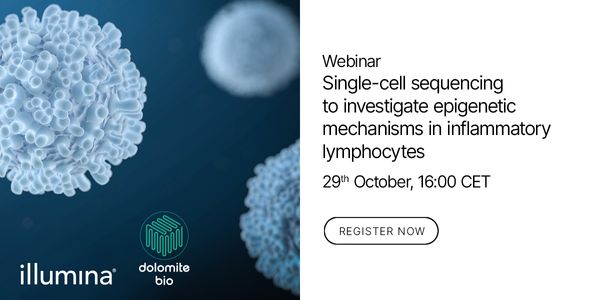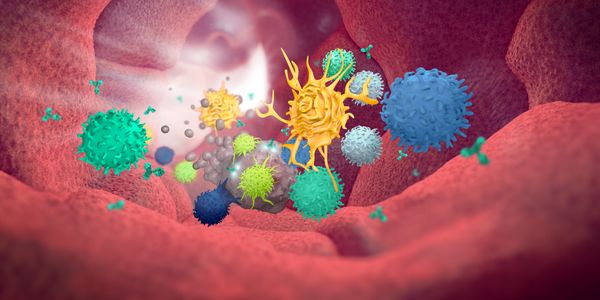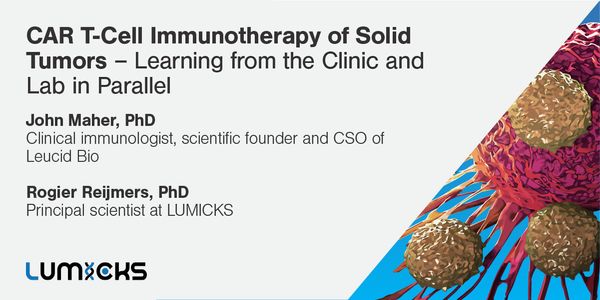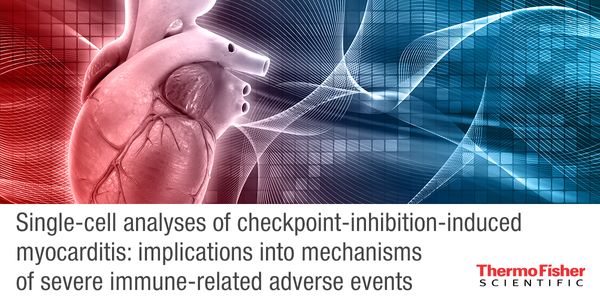T cell functionality
T cells, also called T lymphocytes, are an integral component of the adaptive immune system which seek out and eliminate foreign particles. Functions of T cells include killing infected host cells, activating other immune cells, producing and releasing immune messengers called cytokines into the body, and regulating the immune response. When T cell functionality is hindered by disease, genetics, or environment, the immune system could be at severe risk.
-
OCT 29, 2020 | 6:00 AMDate: October 29, 2020 Time: 6:00am (PDT), 9:00am (EDT), Chronic inflammation can occur as a result of a combination of genetic predispositions and environmental factors. Epigenetic modifica...Speaker: Thomas Ayers, Ph.D. , Pawel Zajac, Ph.D. , Dr. Adam CribbsSponsored By: Illumina, Dolomite BioOCT 20, 2020 | 9:00 AMDATE: October 20th, 2020 TIME: 08:00am PT, 11:00am ET Tumor-associated macrophages (TAMs) are key cells in the tumor microenvironment (TME) with diverse immune functions that have a major in...OCT 08, 2020 | 6:00 PMSoluble cytokine biomarkers are the master regulators of cell-to-cell communication-- the means by which one cell tells another what to do or where to go. Determining the biomarker signature...Speaker: Jenny Koenitzer, PhDOCT 08, 2020 | 3:00 PMThe continued rapid expansion of immunotherapies, including both in vivo and ex vivo therapeutics, has driven the development and adoption of novel tools to study, asses and understand these...Speaker: Benjamin Borgo, PhDOCT 08, 2020 | 7:30 AMIndividuals of under-represented minority ancestry are at disproportional risk for higher incidence and mortality rates for particular cancers. The unequal burden of cancer in certain racial...Speaker: Steven R. Patierno, PhDOCT 08, 2020 | 6:00 AMEvery patient is different and so is every tumor! The term “personalized oncology” today is largely associated with sequencing approaches. Current publications proof more and mor...Speaker: Christian Regenbrecht, PhDPresented at: Cancer Research & Oncology Week Virtual Event Series 2020
Sponsored By: Luminex - A DiaSorin CompanyOCT 07, 2020 | 10:30 AMTumor phenotypes are dictated not only by the neoplastic cell component, but also by the tumor microenvironment (TME), which is inherently immuno-suppressive, is equipped to hamper effector...Speaker: Dr. Sergio RutellaPresented at: Cancer Research & Oncology Week Virtual Event Series 2020
Sponsored By: NanoString TechnologiesSEP 30, 2020 | 10:30 AMCRISPR-based genome editing has accelerated biological research and holds great potential for studying and treating human diseases. The CRISPR-Cas9 system requires a Cas9 nuclease and a guid...Speaker: James Goldmeyer, PhDSEP 23, 2020 | 12:00 PMB cells and tertiary lymphoid structures (TLS) promote immunotherapy response 1:00–1:30 pm PDT Presented By: Rafet Basar, MD...Speaker: Handan Xiang, PhD , Pei-Yu Chen, PhD , Hiranmayi Ravichandran, MS , Rafet Basar, MD , Amir Horowitz, PhDPresented at: 9th Annual Fluidigm Mass Cytometry Virtual Summit
SEP 23, 2020 | 10:30 AMIntestinal organoids are self-organizing, 3D structures derived from either pluripotent stem cells or from primary tissues with the abiltiy to recapitulate some of the spatial architecture a...Speaker: Kevin SuSEP 23, 2020 | 8:00 AMDate: Time: Over the last couple of years, it has become apparent that affinity-tuned CAR T cells display enhanced expansion and prolonged persistence in patients and that this strategy can...SEP 23, 2020 | 12:00 AMExtracellular vesicles (EV) from many cell types have demonstrated therapeutic potential against many different diseases. Inhibiting progress in this area is the capability to produce EVs in...SEP 23, 2020 | 12:00 AMChronic kidney disease (CKD) is a global health threat, affecting over 10% of the world population, including an estimated 37 million Americans. Importantly, glomerular diseases account for...SEP 23, 2020 | 12:00 AMThe extracellular matrix (ECM) is a three-dimensional structure that provides physical support for tissues/organs and biochemical/biomechanical cues for tissue morphogenesis, differentiation...SEP 23, 2020 | 12:00 AMChronic kidney disease (CKD) is a major public health threat, affecting 11-15% of the U.S. population alone. Currently, there are no effective therapies to cure CKD. Drug therapies are not p...SEP 23, 2020 | 12:00 AMLearning Objectives: 1. Understand methods of isolating and enriching exosomes along with their pros/cons of the different techniques 2. What do we mean when we talk about subtyping, and wha...SEP 17, 2020 | 12:00 PMTherapeutic antibody can provide key protection or lifesaving treatment for those who haven't been or can’t be vaccinated, or when vaccines don’t “take". We galvan...SEP 17, 2020 | 1:30 PMThe Allen Institute for Cell Science is generating a state space of stem cell signatures. The goal is to understand cell organization, identify cell states, and elucidate how cells transitio...SEP 17, 2020 | 12:45 PMImmunotherapy such as immune checkpoint inhibitor antibodies have revolutionized the treatments for hard-to-treat cancers, with durable responses observed in clinics. However, the overall re...SEP 01, 2020 | 8:00 AMDATE: September 1, 2020 TIME: 8:00am PT, 11:00am ET Nearly half of all cancer patients are eligible to receive treatment with immune checkpoint inhibitors (ICI). Thus, preventing, identifyin...JUL 29, 2020 | 2:00 PMB7-H3 is actively being explored as an immunotherapy target for pediatric patients with solid tumors using monoclonal antibodies or T cells expressing chimeric antigen receptors (CARs). B7-H...Speaker: Christopher DeRenzo, MDPresented at: Immuno-Oncology & Cancer Biology Virtual Conference
JUL 29, 2020 | 12:00 PMThe major function of mitochondria in cellular homeostasis has been the generation of ATP through oxidative phosphorylation. However, we have previously demonstrated that mitochondria can se...JUL 29, 2020 | 10:00 AMCoordination of immune cell metabolic programs with cell fate and state is a fundamental determinant of immune responses. Emerging evidence highlights that the interplay between immune signa...JUL 29, 2020 | 7:00 AMMetabolic reprogramming is critical for governing proper T cell immune responses, including activation, production of effector molecule, migration and differentiation. The metabolic stress T...
OCT 29, 2020 | 6:00 AM
Date: October 29, 2020 Time: 6:00am (PDT), 9:00am (EDT), Chronic inflammation can occur as a result of a combination of genetic predispositions and environmental factors. Epigenetic modifica...
Speaker:
Thomas Ayers, Ph.D.
, Pawel Zajac, Ph.D.
, Dr. Adam Cribbs
Sponsored By: Illumina,
Dolomite Bio
OCT 20, 2020 | 9:00 AM
DATE: October 20th, 2020 TIME: 08:00am PT, 11:00am ET Tumor-associated macrophages (TAMs) are key cells in the tumor microenvironment (TME) with diverse immune functions that have a major in...
OCT 08, 2020 | 6:00 PM
Soluble cytokine biomarkers are the master regulators of cell-to-cell communication-- the means by which one cell tells another what to do or where to go. Determining the biomarker signature...
Speaker:
Jenny Koenitzer, PhD
OCT 08, 2020 | 3:00 PM
The continued rapid expansion of immunotherapies, including both in vivo and ex vivo therapeutics, has driven the development and adoption of novel tools to study, asses and understand these...
Speaker:
Benjamin Borgo, PhD
OCT 08, 2020 | 7:30 AM
Individuals of under-represented minority ancestry are at disproportional risk for higher incidence and mortality rates for particular cancers. The unequal burden of cancer in certain racial...
Speaker:
Steven R. Patierno, PhD
OCT 08, 2020 | 6:00 AM
Every patient is different and so is every tumor! The term “personalized oncology” today is largely associated with sequencing approaches. Current publications proof more and mor...
Speaker:
Christian Regenbrecht, PhD
Presented at: Cancer Research & Oncology Week Virtual Event Series 2020
Sponsored By: Luminex - A DiaSorin Company
Sponsored By: Luminex - A DiaSorin Company
OCT 07, 2020 | 10:30 AM
Tumor phenotypes are dictated not only by the neoplastic cell component, but also by the tumor microenvironment (TME), which is inherently immuno-suppressive, is equipped to hamper effector...
Speaker:
Dr. Sergio Rutella
Presented at: Cancer Research & Oncology Week Virtual Event Series 2020
Sponsored By: NanoString Technologies
Sponsored By: NanoString Technologies
SEP 30, 2020 | 10:30 AM
CRISPR-based genome editing has accelerated biological research and holds great potential for studying and treating human diseases. The CRISPR-Cas9 system requires a Cas9 nuclease and a guid...
Speaker:
James Goldmeyer, PhD
SEP 23, 2020 | 12:00 PM
B cells and tertiary lymphoid structures (TLS) promote immunotherapy response 1:00–1:30 pm PDT Presented By: Rafet Basar, MD...
Speaker:
Handan Xiang, PhD
, Pei-Yu Chen, PhD
, Hiranmayi Ravichandran, MS
, Rafet Basar, MD
, Amir Horowitz, PhD
Presented at: 9th Annual Fluidigm Mass Cytometry Virtual Summit
SEP 23, 2020 | 10:30 AM
Intestinal organoids are self-organizing, 3D structures derived from either pluripotent stem cells or from primary tissues with the abiltiy to recapitulate some of the spatial architecture a...
Speaker:
Kevin Su
SEP 23, 2020 | 8:00 AM
Date: Time: Over the last couple of years, it has become apparent that affinity-tuned CAR T cells display enhanced expansion and prolonged persistence in patients and that this strategy can...
SEP 23, 2020 | 12:00 AM
Extracellular vesicles (EV) from many cell types have demonstrated therapeutic potential against many different diseases. Inhibiting progress in this area is the capability to produce EVs in...
SEP 23, 2020 | 12:00 AM
Chronic kidney disease (CKD) is a global health threat, affecting over 10% of the world population, including an estimated 37 million Americans. Importantly, glomerular diseases account for...
SEP 23, 2020 | 12:00 AM
The extracellular matrix (ECM) is a three-dimensional structure that provides physical support for tissues/organs and biochemical/biomechanical cues for tissue morphogenesis, differentiation...
SEP 23, 2020 | 12:00 AM
Chronic kidney disease (CKD) is a major public health threat, affecting 11-15% of the U.S. population alone. Currently, there are no effective therapies to cure CKD. Drug therapies are not p...
SEP 23, 2020 | 12:00 AM
Learning Objectives: 1. Understand methods of isolating and enriching exosomes along with their pros/cons of the different techniques 2. What do we mean when we talk about subtyping, and wha...
SEP 17, 2020 | 12:00 PM
Therapeutic antibody can provide key protection or lifesaving treatment for those who haven't been or can’t be vaccinated, or when vaccines don’t “take". We galvan...
SEP 17, 2020 | 1:30 PM
The Allen Institute for Cell Science is generating a state space of stem cell signatures. The goal is to understand cell organization, identify cell states, and elucidate how cells transitio...
SEP 17, 2020 | 12:45 PM
Immunotherapy such as immune checkpoint inhibitor antibodies have revolutionized the treatments for hard-to-treat cancers, with durable responses observed in clinics. However, the overall re...
SEP 01, 2020 | 8:00 AM
DATE: September 1, 2020 TIME: 8:00am PT, 11:00am ET Nearly half of all cancer patients are eligible to receive treatment with immune checkpoint inhibitors (ICI). Thus, preventing, identifyin...
JUL 29, 2020 | 2:00 PM
B7-H3 is actively being explored as an immunotherapy target for pediatric patients with solid tumors using monoclonal antibodies or T cells expressing chimeric antigen receptors (CARs). B7-H...
Speaker:
Christopher DeRenzo, MD
Presented at: Immuno-Oncology & Cancer Biology Virtual Conference
JUL 29, 2020 | 12:00 PM
The major function of mitochondria in cellular homeostasis has been the generation of ATP through oxidative phosphorylation. However, we have previously demonstrated that mitochondria can se...
JUL 29, 2020 | 10:00 AM
Coordination of immune cell metabolic programs with cell fate and state is a fundamental determinant of immune responses. Emerging evidence highlights that the interplay between immune signa...
JUL 29, 2020 | 7:00 AM
Metabolic reprogramming is critical for governing proper T cell immune responses, including activation, production of effector molecule, migration and differentiation. The metabolic stress T...
























